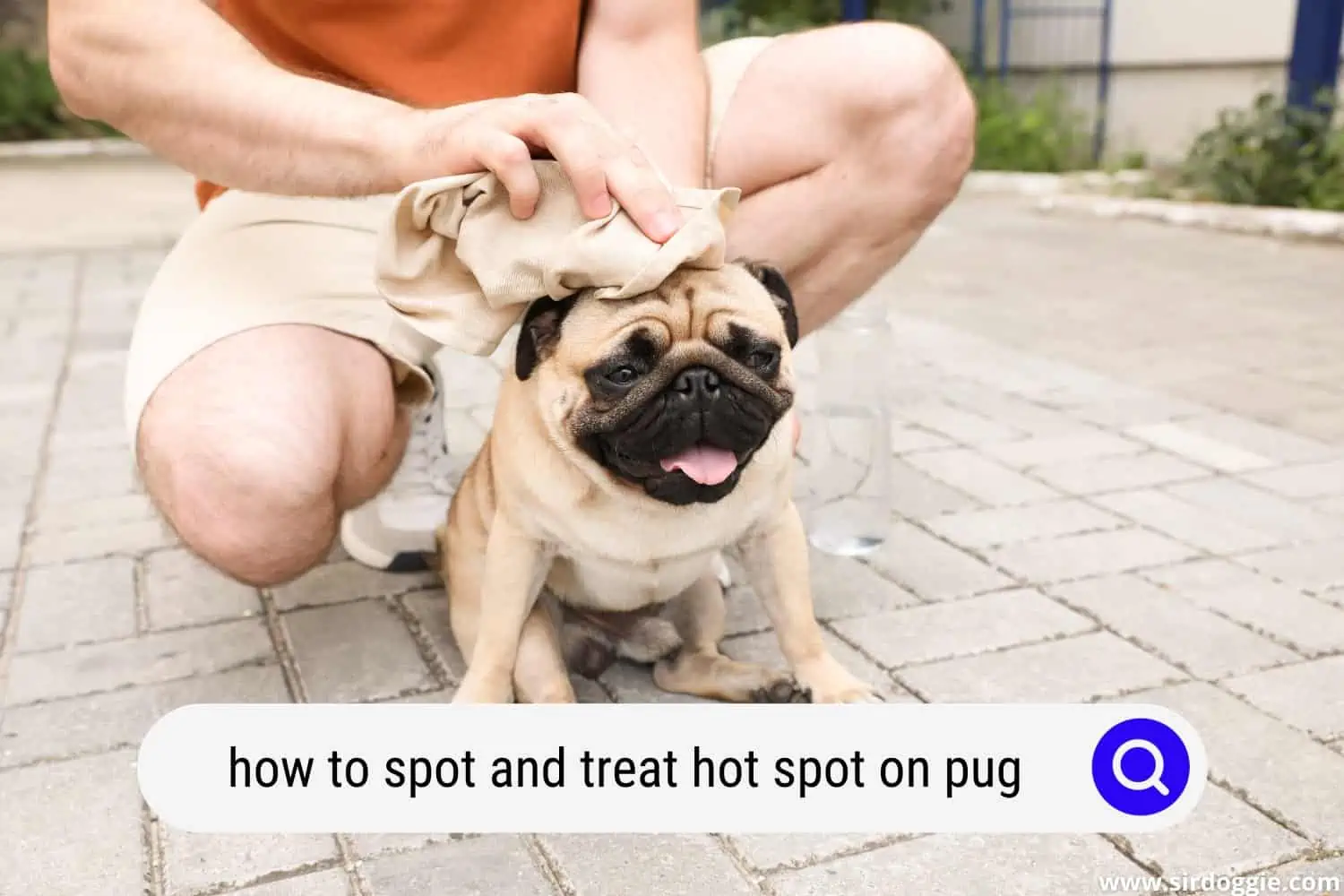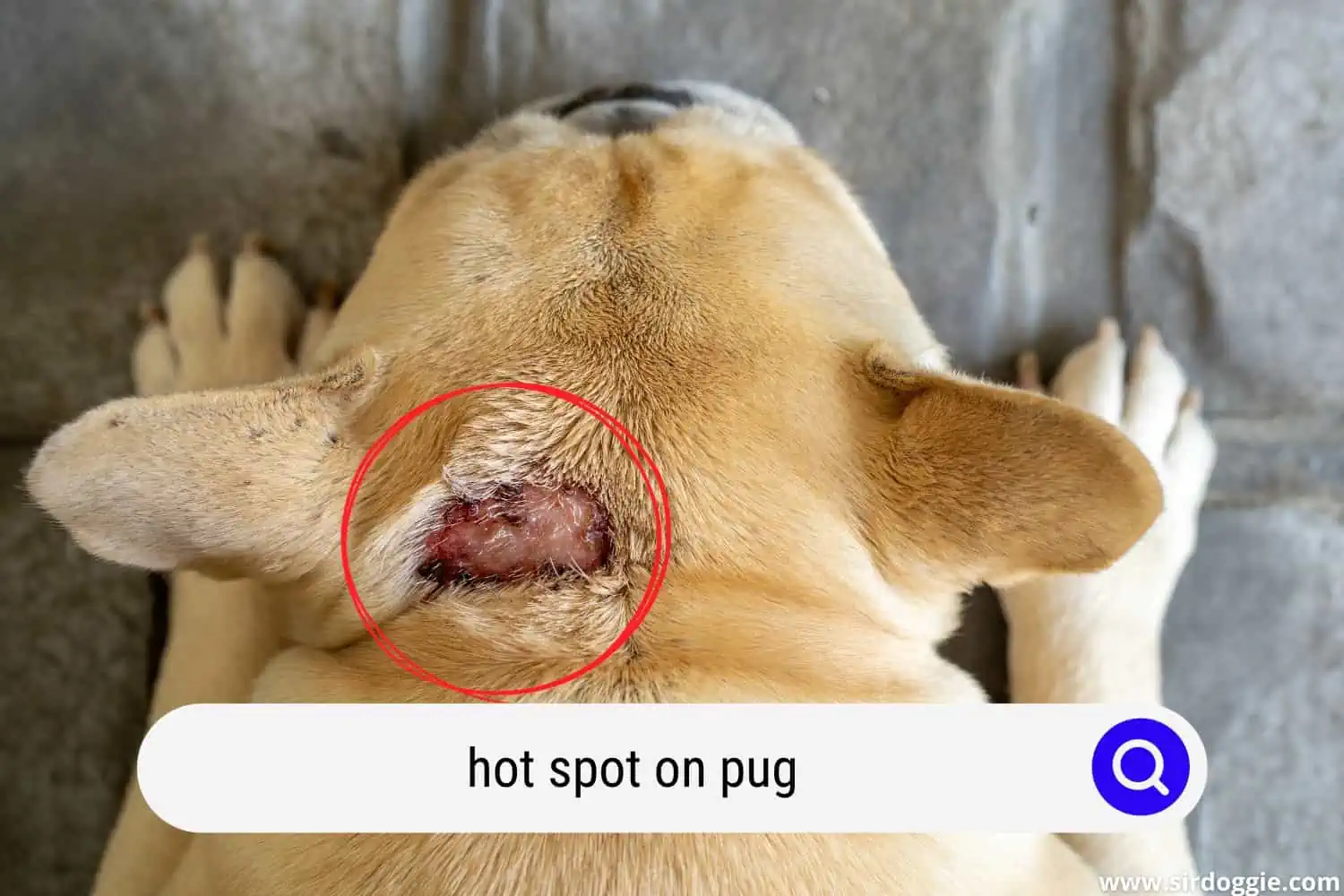How To Spot and Treat Hot Spot On Pug?
Many owners are curious about the hot spot on a pug. That isn’t a specific skin illness, and it’s a condition that develops as a result of another problem. Dry skin can be the culprit, especially in the winter when the air is dry and chilly, but it’s more likely to be an allergic response.
These are parts of the body that are red and swollen. They are most common in places like the lower back, and you may find them almost everywhere.

What Is A Hot Spot On Dogs?
Hot spots also known as acute moist dermatitis, are small patches of skin irritation and infection. A hot spot frequently starts as a little red patch that owners mistake for an insect bite. A hot spot unlike an insect bite may quickly deteriorate and spread, so over time, can become a hot, red, oozing, and painful sore.
Dog hot spot healing stages
It’s critical to keep an eye on your dog’s hot areas to make sure they’re healing properly. If your dog’s hot spots do not develop in this manner, you should contact your veterinarian.
Stage 1
The hot area should fade from bright red or yellow to pink or pastel pink within 72 hours.
Stage 2
Swelling should subside, and the hot region should no longer feel warm to the touch. The hue will gradually fade from light pink to white.
Stage 3
The wound’s edges should start to fill up with new flesh and shrink.
Stage 4
The wound will begin to “knit” with new tissue.
Stage 5
Finally, the fur will grow back, and the skin will seem normal.
What Causes A Hot Spot On Pug?
Scratching, licking, or chewing the afflicted region is a common cause of hot spots. Inflammation and subsequent bacterial infections develop from the resultant skin damage. Unfortunately, this self-trauma makes the place itchier, leading to a vicious cycle of scratching and itching.
As a result, every condition that makes your dog itch has the potential to develop a hot spot. The following are some of the most common reasons for the itching/scratching cycle in dogs:
- Allergies to foods
- Parasites
- Dermatitis flea allergies
- Infections of the ears or skin
- Anal sac illness is a condition that affects the anal sac
- Excessive licking as a result of stress or boredom
- Swimming or bathing moisture trapped in the coat
- Irritating substances in contact
- The fur that is matted or filthy
Many of these disorders are long-term issues that, if not treated properly, can result in recurrent hot spots. One of the most critical components in preventing future skin issues in your dog is identifying and treating the underlying cause of the hot spot.
Related Reading: Pug’s Skin Rashes: Common Types and What To Do About Them
Treatment For Hot Spots On Dogs
A visit to your veterinarian is the first step if you believe your dog has a hot spot. While it may be tempting to wait for the hot area to go away on its own, doing so would exacerbate the situation.
Your veterinarian will need to establish the underlying cause of the hot spot to treat it and prevent it from repeating. They will give your dog a thorough physical examination and may suggest extra tests, such as a skin scrape to check for parasites.
Your veterinarian will prescribe suitable medication after the underlying reason for your dog’s itching has been identified.
- Hot spot treatment usually entails a mix of the following:
- To avoid matting, clip the hair surrounding the region.
- Chlorhexidine is a light antiseptic that you can clean the afflicted
- Prescription of antihistamines to treat the underlying cause of itching.
- Cleaning the region using medicated wipes or solutions daily.
- Antibiotics, either topical or oral, are prescribed to treat secondary bacterial infections.
- Bathing dogs with a chlorhexidine shampoo.
- To avoid scratching is advised to use an Elizabethan collar.
Once your vet treats the hot spot, your dog is most likely to improve rapidly. In some cases, hot spots resolve in 4 to 6 days after the beginning of the treatment.
Related Reading: 8 Of The Best Shampoos For Pug Puppies and Dogs.
Treating hot spots – Cost
If you address the hot spots as soon as possible, the expenditures should be minimal. The veterinarian’s consultation and likely prescription expenditures would be the most significant expenses. If you or the vet cannot spot the hot area, the badly injured skin might die and create a wound.
That can greatly raise the expense of treatment as well as the time it takes to recover.
Can hot spots cure on their own?
A hot spot will not be gone on its own because dogs have a hard time letting their sensitive skin alone. A hot spot is simpler to avoid than to treat, so clean your dog frequently and keep them up to date on flea and tick treatments to keep them clear of them.
If your dog enjoys swimming, make every effort to get them dry as quickly as possible after removing them from the water, especially if they have long hair or a double coat.
How Does A Hot Spot On Pug Look Like?
The size of the hot spot lesion varies, but it is generally red, inflamed, and raw, with occasional bleeding.
The region will become wet and uncomfortable, and things like licking, chewing, or scratching will usually spread the wound. Because the skin is particularly wet and inflammatory, hot spots on dogs seem different from other skin disorders like ringworm or mange.
Hair loss is common with ringworm and other parasitic skin illnesses, they are generally drier in appearance than hot areas.
Is It Possible For Humans Or Other Pets To Catch Canine Hot Spots?
Bacteria produce the majority of dog hot spots, which are not communicable to other dogs or people. If the vet discovers that the cause of the hot spots is fungal or parasitic, the infection will likely spread to other canines and humans.
Contact your veterinarian right once to have a sample taken and culture performed to determine the source of the hot areas.

Conclusion On Hot Spot On Pug
Pug skin disorders vary, and most dogs will get one at some point in their lives. To help reduce the danger, give your Pug high-quality food, keep their skin clean and dry, and perform daily checks on them.
Make sure to clean their ears regularly. Pug skin allergies can develop fast in darker and wetter places, like the ears, so avoid getting water in them and, if you do, dry it up immediately.
Related Reading: Why Is My Dog Losing Hair Only On Its Tail?.

Family Dog Expert Author
Hi there! I’m Stuart, a devoted dog lover and family dog expert with over a decade of experience working with our furry companions. My passion for dogs drives me to share my knowledge and expertise, helping families build strong, loving bonds with their four-legged friends. When I’m not writing for SirDoggie, you’ll find me hiking, playing with my beautiful dog, or studying music.